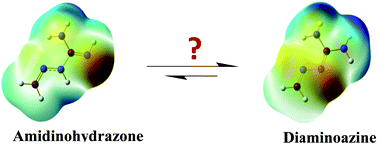Azine or hydrazone? The dilemma in amidinohydrazones†
Abstract
Azines belong to an important class of compounds that are found to have numerous applications in medicinal chemistry. Hydrazones are related to azines and are more widely known compounds that carry many biochemical applications. Hydrazones with appropriate substituents can show azine–hydrazone tautomerism. There are many cases in which azines are wrongly considered to be hydrazones. In this article, we report the tautomeric energy differences of azine and hydrazone and provide the structural details of amidinohydrazones, which prefer azine structure rather than that of hydrazone structure, an important example being the anti-hypertensive drug, guanabenz. The importance of appropriate tautomeric representation of guanabenz has been established in terms of its molecular interactions with a known enzyme.


 Please wait while we load your content...
Please wait while we load your content...